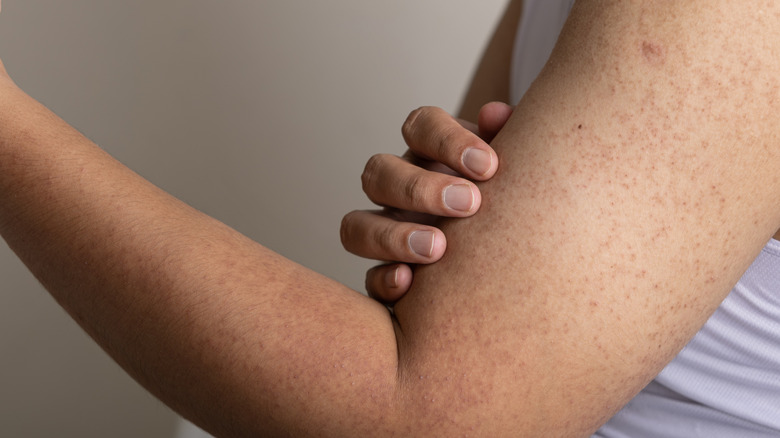
If you’ve noticed bumpy patches on your neck, you might be dealing with a common skin condition called keratosis pilaris. Often referred to as “chicken skin” due to its texture, this condition typically shows up on the upper arms, thighs, cheeks, or buttocks — but it can also appear on the neck, forearms, or lower legs. Essentially, any area with hair follicles is susceptible.
The bumps linked to keratosis pilaris consist of excess keratin. They may feel rough and can vary in color depending on skin tone. The skin around these bumps might be discolored, itchy, and dry. While anyone can develop keratosis pilaris, it is more prevalent in babies, young children, and teenagers. This condition is neither harmful nor contagious and often resolves by the mid-20s. In most cases, it will have completely disappeared by age 30.
What causes keratosis pilaris

Keratin is the protein that makes up your hair, skin, and nails. When keratin does not flake off properly, it can clog pores, leading to the formation of bumps.
Factors that may predispose you to develop keratosis pilaris include having fair skin (although it can occur in all skin tones), eczema, ichthyosis vulgaris, asthma, hypothyroidism, Cushing’s syndrome, diabetes, Down syndrome, and obesity. There is also a potential genetic link, as you are more likely to develop keratosis pilaris if another family member has it as well.
StatPearls further explains the genetics associated with keratosis pilaris, noting that mutations in the protein filaggrin and issues with the Ras signaling cascade have been linked to this condition. Keratosis pilaris is often associated with atopic dermatitis, and along with mutations in the filaggrin gene, this supports the theory that the condition may stem from abnormal epithelial barrier function.
How keratosis pilaris is treated

The American Academy of Dermatology Association suggests a three-step self-care routine to manage keratosis pilaris. They recommend gentle exfoliation using a loofah, buff puff, or rough washcloth to remove dead skin cells, followed by applying a product containing alpha hydroxyl acid, glycolic acid, lactic acid, a retinoid, salicylic acid, or urea to further promote the shedding of dead skin cells. After exfoliating, ensure you apply a moisturizer and reapply after bathing or whenever your skin feels dry. Avoid overly aggressive exfoliation, and take a break for a few days if your skin becomes dry or irritated (here’s what happens if you exfoliate too much). If these measures are not sufficient, they advise consulting a dermatologist for further guidance.
If you consult a dermatologist, you might receive a prescription steroid cream for a week to 10 days to reduce inflammation, followed by a combination of urea cream and salicylic acid. Retinoids may also be used weekly or biweekly. If creams do not provide relief, there are minor surgical procedures your doctor can consider. For example, a small tool may be used to cut the skin and remove trapped hairs and keratin plugs. Other options include dermabrasion, microdermabrasion, chemical peels, and light or laser therapies to clear blockages. If you have hyperpigmentation, your dermatologist might recommend using creams such as hydroquinone, azelaic acid, and kojic acid to lighten those areas.
“`




